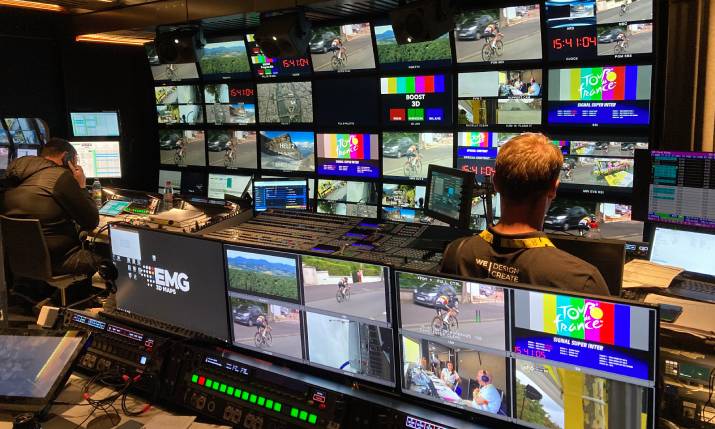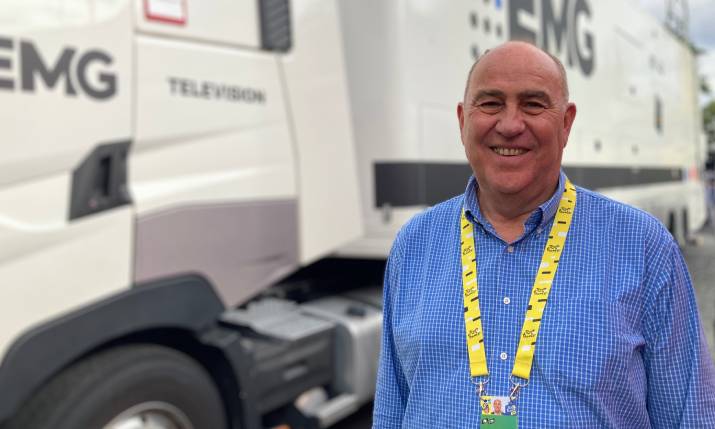Live from the Tour de France 2023: Inside EMG’s production of the legendary men’s and women’s cycling races

Inside EMG’s Nova 104 OB van that the Boost Graphics team works out of, receiving data and providing graphics for the international signal during the Tour de France 2023
European service provider EMG has brought its expertise in RF, data, and graphics to the 2023 Tour de France for both men and women. Its knowhow ensures the visual coverage of international cycling.
Without the crew at EMG there would be few images of the Tour de France. The crew supports the TV production of host broadcaster France Télévisions, under the guidance of Amaury Sport Organisation (ASO), the organiser and producer of the Tour de France.
More than a hundred of EMG staff travel across France during the three weeks of the legendary cycling race accompanied by various mobile resources including motorcycles, OB vans, RF cameras, and helicopters. Additionally, for the past two years EMG teams and mobile units have also been involved with the Tour de France Femmes.
Historically, EMG has supported the Tour with its RF services. However, today the set up is refined and enables viewers from around the world to follow the stages live and in their entirety.
Altogether, 14 motorcycles (six camera motorcycles, seven commentator motorcycles, and one spare,) are deployed by the service provider to closely follow the peloton.
Three RF vans receive their signals on the route of each stage: the RFI 5, 6, and 7 vans. The HFR 42 semi-trailer hosts coordination and reception of all RF signals at the finish line, and is connected by fibre to the France Télévisions outside broadcast van.
In the air, two twin-turbine helicopters provide the images, flying over urban areas to bring fantastic images to audiences globally. Each is equipped with two gyrostabilised GSS cameras. A third helicopter acts as a relay for RF connection with the plane and a final helicopter is available in case of need.
Also, two pressurised Beechcraft 200 airplanes relay RF signals between motorcycles, helicopters, and reception vans. They fly constantly above the cyclists. As all images pass through the relay plane, having a second one is necessary to avoid signal interruption.
“Both planes can transmit all the feeds,” assures Bruno Gallais, managing director of EMG Connectivity, EMG’s dedicated RF business unit.

Bruno Gallais, managing director at EMG Connectivity and CEO at EMG France, at the finish line of the 2023 Tour de France in front of EMG’s HFR42 van
Tracking precision
In addition to images, EMG has developed tracking solutions to follow the race using data. Sensors called SMACS are installed under the saddles of all male and female Tour bicycles. They are subjected to a weight constraint in a sport like cycling, where each gram affects performance. Gallais specifies: “The chips weigh less than 80 grams, which makes them negligible compared to the weight of the 6.8 kg bicycle.”
The sensors transmit position, speed, altitude, and slope information. Gallais praises, “a precision of less than a metre, more accurate than a GPS beacon. There’s no equivalent in the world”.
The data is then processed in the Nova 104 production van, where technicians from Boost Graphics, EMG’s subsidiary specialised in graphics, come in. Altogether seven graphics feeds are available to provide the international signal with graphics. The data from SMACS trackers are dressed in race colours for the screen, showing gaps between leaders and the peloton, or the composition of the breakaway, for example.
Through pixel tracking, it is also possible to display a rider’s name and speed from a helicopter view. By cross-referencing data from sensors, comparing positions and gaps, a virtual general classification can be generated in real time during the race.
Finally, 3D marks allow the race to be shown in a Google Earth-like style, with the positions of riders akin to a video game. It has an added service for rights holding TV channels.
Tailored Tour de Femmes
EMG has also been at work on the second edition of the Tour de France Femmes. Jérôme Bailly, project manager in charge of TV production and broadcaster services at ASO, claims to want to, “maintain the same level of production quality as on the Men’s Tour de France”.
But with a smaller budget for the women’s race, solutions had to be found. EMG limited the number of RF motorcycles to only three plus only one helicopter. SMACS sensors are well-positioned on the bicycles of female cyclists but instead of seven graphics feeds, only five are sent to the France Télévisions production van from Boost Graphics’ GFX4 van. The female riders benefit from the technological advancements developed for La Grande Boucle, albeit with a few less options.
Yet the reverse is also true, as the EMG innovation, Team Radio, tested on the Tour de France Femmes last year was introduced this year in the men’s Tour de France.
Technical and logistical challenges
Going forwards, several technical challenges remain to be solved for the service provider. This includes the planned transition to UHD and the possible miniaturisation of RF cameras. Placed on bicycles, these tiny cameras could provide a new perspective from the heart of the peloton.
Team Radio, which made its debut this year in the Tour de France, could go even further in terms of personalisation, depending on international TV channels. More concretely, EMG will have to find logistical solutions next year as the Tour de France’s finish will take place just three days before the opening of the Olympic Games. This is a challenge that EMG seems ready to take on, as this year they had to split their teams between the Men’s and Women’s Tours. Watch this space!

